How to decorate a flower bed with your own hands from improvised materials. DIY flowerbeds from improvised materials: photo. Simple flower bed of bottles
We always, everywhere strive to surround ourselves with beauty. Flowers themselves are the decoration of our cottages, garden plots. Even the garden wants to be beautiful! An interesting frame - the design of flower beds, flower beds only emphasizes this beauty. We will not now consider those cases when a certified specialist in landscape design. Let's look at how you can creatively arrange flower beds and flower beds with your own hands from improvised materials, photos will be attached below.
Instructions for the construction of flower beds in the country with their own hands for beginners
Luanne Hughes, Community Health Education and Health Educator, Gloucester County Denelle DiClaudio, University Relations Secretary at Rowan Lianne Savoca, Health and Social Sciences Program Assistant, Gloucester County. School gardens are a wonderful and exciting way to bring virtually any classroom curriculum to life and show “ real life' which means to learners when they are learning. The garden can provide students with the opportunity to participate in practical training which teaches not only the intended subject but also responsibility, teamwork and respect for nature, others and oneself.
Using your imagination and, sometimes, things that are completely incompatible with the floral theme, you can not only decorate your site, but also give it individuality. Flower beds complete flower plantings, and also perform a protective function. Thus, the roots of ground cover plants are held back by the sides of the original fences, and do not spread over the site. In addition, flower beds act as limiters for curious pets who are not averse to frolic in your flower garden. Even a chipped jug, a sawn log, or outdated car tires can be used as an option for new design solutions. Consider some of the creative techniques of gardeners-summer residents. 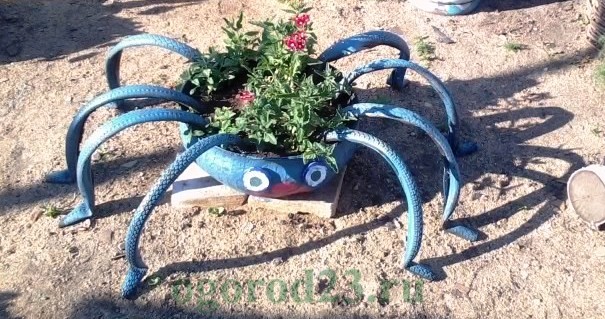
Gardens have been shown to help students learn better and improve test scores, and they can be an attractive way to meet core curriculum content standards. Whether growing vegetables, fruits, or various herbs, edible gardens are a valuable tool that schools can use to promote healthy eating habits, value local food sources, teach environmental leadership, encourage community and social development and even give a sense of place.
School gardens and academic achievement
Gardens can serve as living laboratories in which students see and learn firsthand what they are learning and in turn apply that knowledge to real situations. When students participate in practical gardening activities, they show an increase in positive attitudes towards the content and learning in general. Research shows that education acquired in kindergarten can improve student achievement levels.
Tires or car tires- these are ready-made small flower beds that are painted in the desired color, and then set on level ground. Fertile soil is poured inside the tires, flowers are planted. You can also figuratively cut out the top of the tire or even give it an intricate shape. 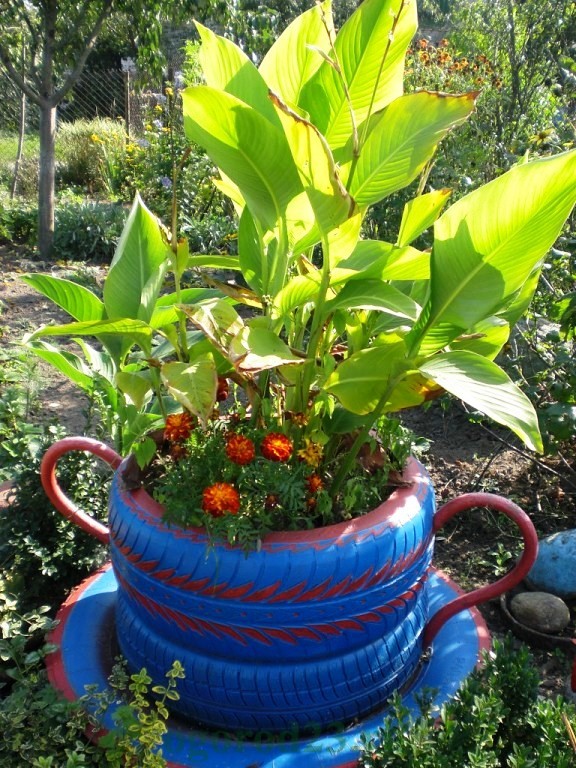
Students who participate in school gardens show significant gains in the middle middle class, particularly in math and science. Teachers believe that introducing new learning styles can help students learn more effectively. Students expand their ways of thinking or habits of mind to include curiosity, flexibility, openness, informed skepticism, creativity, and critical thinking. Here are some examples of how using school gardens can improve learning in the school environment.
What can a flower bed be made of?
Gardens can provide students with the opportunity to explore and compare the basic physical characteristics of plants, what helps or hinders their growth, and their response to stimuli and conditions. environment throughout the season. Students also have the opportunity to observe the similarities and differences in the needs of various living beings and the differences between living and non-living things. Students can keep a scientific journal to record observations, collect data, and keep notes and drawings in the garden. Students of all ages can learn about the scientific method by experimenting in the garden.
Tires in general represent an extensive field of activity for a creative gardener: they are hung on a fence (for ampelous plants), mounted on top of each other (for vertical gardening), stylized as various shapes. 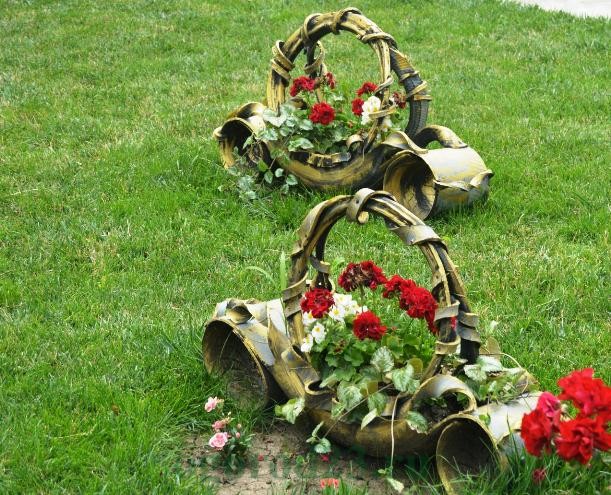
You can also give an old bike new life, after updating it with paint. Drawers, containers with soil are installed or hung on the trunk, frame, seat, even on the pedals, in which flowers will then grow. In this case, the main thing is to securely fasten the bike and its moving parts. A metal pin is usually used, which is buried in the ground, and then the former mobile vehicle is tied or welded to it.  Such a mobile flower bed looks very unusual, while saving space. You can also lean the bike against the fence and tie it well.
Such a mobile flower bed looks very unusual, while saving space. You can also lean the bike against the fence and tie it well.
Gardens give young students the opportunity to identify, analyse, compose and compare forms; classify objects; and count the number of objects in each category. For example, students can look for triangular shapes in a garden and explore their characteristics. Gardens give older students the opportunity to work with numbers while planting seeds; bases of strengthening of cost of a place; and solve practical computing problems. For practical garden area calculation and linear measurement, students could plan the area of a garden plot and then calculate the estimated distance between seeds or seedlings.
It will be interesting to look at a garden wheelbarrow in the form of a flower bed. It is better to pre-sand the old metal structure and renew it with spray paint, the wooden one will look good on its own. Wheelbarrow elements can be partially dug into the ground to give it stability. 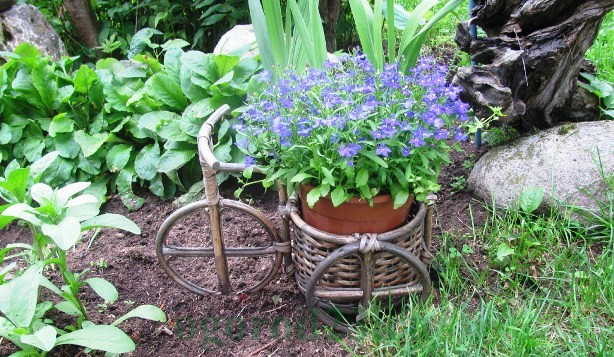
How to choose the right type of flower beds for flowers with your own hands: photos and professional recommendations
The garden journal can be a book or any written or recorded diary in which students can write their daily or weekly thoughts about the school garden all year round. These may include photographs of plants, weather conditions, gardening tips, and lessons learned. It simply helps them remember all the different things they learned while gardening and demonstrates an understanding of the organization and basic features of printed and spoken words, syllables and sounds.
Old chairs with and without seats can act as stands for small flower containers. Such a flower bed can be moved anywhere or installed permanently, partially digging the legs into the ground.
A durable option is a flower bed made of stones. Cobblestones, bricks, ordinary stones are used. Such flower beds can be multi-tiered. 
Gardens can be used as a means of self-expression through the creation and performance of music and can help students listen, imitate and improvise sounds, patterns and songs. Students can learn a song about plants and sing along - or the song can be included as part of any seasonal concert.
Gardens can provide an opportunity for students to expand their knowledge and knowledge of art as they paint something found in nature or the natural environment. By looking closely at plants, students can create leaf cuts, drawings, and paintings from the plants in the school garden. Or students can create alternative garden art projects by creating toad houses, root-view boxes, solar dryers, and raincoats. Students invariably discover new things about plants when they draw them.
You can also arrange fences for flower beds from half dug into the ground plastic bottles. They are placed one after another, the shape of the flower garden can be absolutely any. 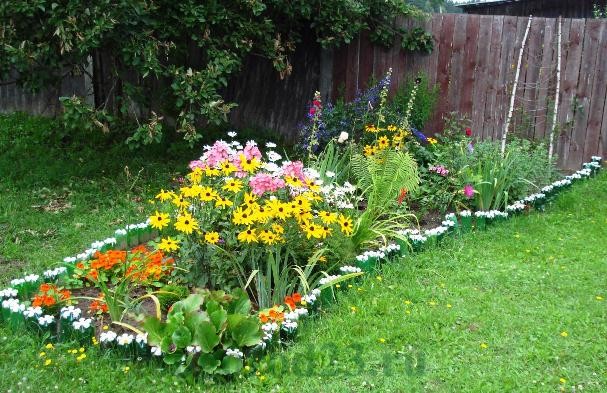
Separate containers are used as hanging planters, for example, on a fence - ampelous petunias look good in such a frame. From large five-liter containers, you can make mini-flower beds in the form of animals. 
In the garden, students receive substance and visual cues and better describe objects. They can also identify elements of art and design principles that are evident in Everyday life. Garden nutrition can encourage students to eat healthy and increase physical activity. desire to eat more healthy food is what children learn in the garden. A garden can create enthusiasm for eating fresh and possibly local fruits and vegetables. The process of planting their own seeds, watching them grow into plants, preparing the grown food and eventually eating it can give students a new and sustainable perspective on healthy eating.
Fences from glass bottles- the oldest way to decorate flower beds and flower beds with your own hands. Often, champagne bottles are used for this - they are thick-walled, they have a powerful bottom. Such a flower bed will serve you for more than one year. 
With imagination, a garden saw and an ax, you can make amazing flower beds from the trunks of sawn trees, stumps. The log is usually used as a whole or sawn into fragments that are used to decorate miniature flower beds. The bark is either removed or left untouched - this gives even more "naturalness", decorativeness. 
Research shows that horticultural nutrition education improves eating habits by increasing their knowledge, preference, and consumption of fresh fruits and vegetables. Increasing your physical activity while gardening can be quite simple and straightforward. Gardening, in itself, is a great exercise. General gardening activities such as planting, digging, weeding, and harvesting can burn about 135 calories in half an hour for a 125-pound person.
There is growing concern about the possible lack of understanding and connection that children today may have with their environment. As children spend more leisure and structured time indoors and less overall time outdoors, they are deprived of opportunities for imaginative play and learning outdoors and experiencing how food grows, how plants survive, and the general benefits of natural settings. School gardens can compensate for some of this by offering students the opportunity to reconnect with nature and their environment. can teach students agriculture, food systems, nutrition, environmental protection and nature.
The flower garden from previously sawn and peeled logs looks interesting. In the photo below, the flower bed is stylized as a well. 
Even from a sawn trunk of a medium-sized tree, you can make a decorative fence and enclose a flower garden. 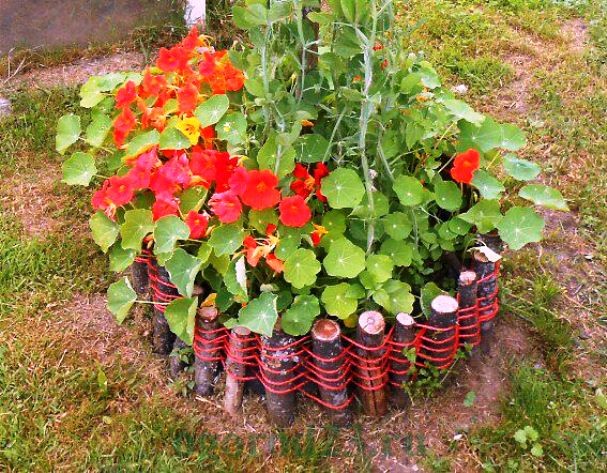
Students thrive when they take what they have learned in class and practice it in real situations, especially through controlled farming experiences. Project-based learning improves students' knowledge and understanding of ecology and the environment. The garden offers an ideal area for teaching and reinforcing the ideas and concepts of plant science, biology, chemistry, soil science and mathematics. Students develop an understanding of the natural when they are actively engaged in scientific research. Gardens can facilitate and support such development.
Even ordinary wooden boards or fragments of timber can be used to fence flower beds. 
You can make a multi-tiered flower garden with your own hands from several pots put on an iron pin, which is dug into the ground. And if the pots differ in size, it will be even more interesting. 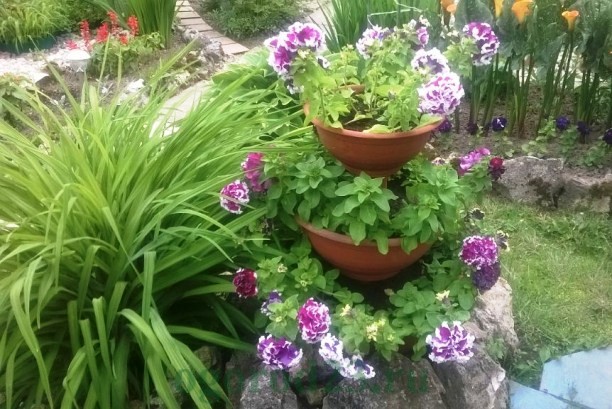
It is shown that work in school gardens affects the social and emotional development of students. When students participate in practical gardening activities, they show great concern and willingness to take care of living things. Trying new things like gardening teaches children to take risks, thus expanding their experience and abilities. Differences can be made in the student's relationship to the school and interpersonal relationships with teachers and other students. cacti cacti - perennials, which can be of a wide variety: tree-like, climbing, bare or even columnar, like these long cactus candles.
If you still have an old bath after the repair, why not use it as a flower bed, moreover, it is almost ready. You can dig it into the ground to any depth or leave it in its original form. If you paint it in the color you like, the newly appeared flower bed will only become more attractive. 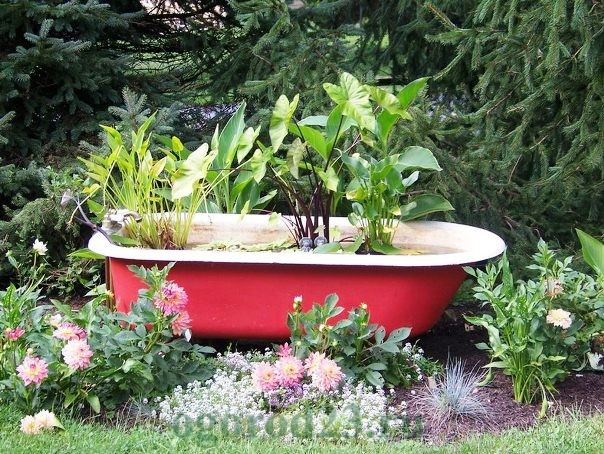
The exposure should be very bright, without direct sun. They require very little watering, once a week. We will choose fairly sandy ground. Have fun putting together a small series of terracotta or ceramic cactus pots in different shapes. Then place them in the center of the table or align the bow. Finally, whisper to them these words of Jacques Dutronz: "Mini, mini, mini, all the minis in our lives" and "There are cacti in life." They will feel right at home and so will you!
Logs, logs and stumps
Aromatic plants at your fingertips. As decorative as they are useful in the kitchen, aromatic plants earn our sunny kitchens. Basil, chervil, wild garlic, parsley, thyme, coriander, wild thyme, onion, watercress, dill, tarragon, bay sauce, mint, rosemary, sage, savory, as many small pots as possible! Most herbs are annuals and don't like to be watered too often. Attention, everyone does not share the same needs: basil loves semi-shade and classic earth, while thyme prefers full sun and a draining substrate.
Anything is used to create flower beds, quite neat fences and fences are obtained from the remnants of building materials. 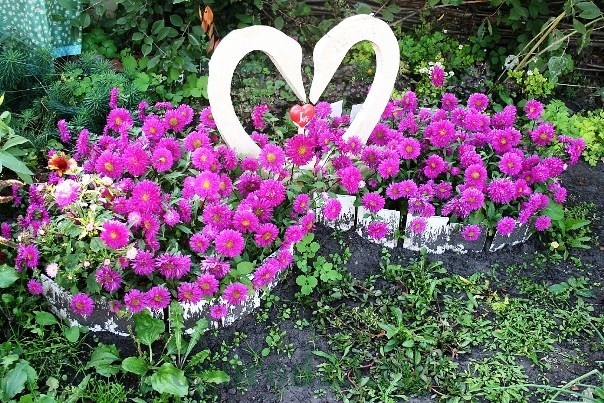 If you approach the matter creatively, then you can beat any more or less suitable material and give it a new life. For example, from a vine and suitable twigs, you can arrange flower beds-baskets that will look unusual, but symbolic.
If you approach the matter creatively, then you can beat any more or less suitable material and give it a new life. For example, from a vine and suitable twigs, you can arrange flower beds-baskets that will look unusual, but symbolic. 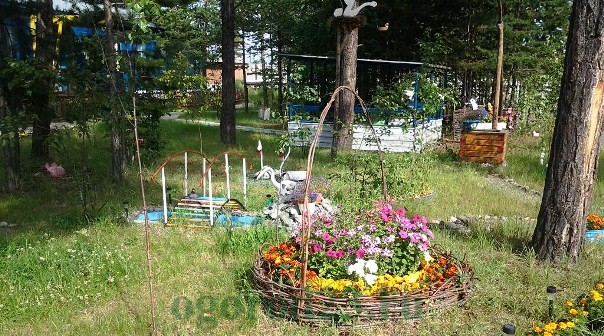
Do not sow, but transplant the plant in a ball. Leave to divide it into two or three small pots as soon as it appears! Flowering Plants Here, a small white-stone gloxinia and three ground squirrels have taken up residence in the cups for a natural and original atmosphere. In a miniature format and a pleasant environment, you will be able to tempt other varieties that are easy to cultivate: small begonia or calenchoe, very blooming, bluebells brought from the garden, purple from Persia, a small perennial valued for its delicate aroma.
As for the miniature gerbera with its large daisy-shaped flowers and its vibrant blooms, it will charm vintage-style decorators! Remember to water them twice a week. Succulents and small bulbous flowers. Succulents are succulent, perennial plants that grow in the smallest rock formation. They live with little water and most often reproduce from a simple fallen leaf that is planted so that it regenerates roots. This means that on the adaptation side, they are the champions!
You can also give a second life to things that have long served their purpose. For example, children's balls, if carefully cut into halves and filled with soil, turn into pretty flowerpots. 
An old basket, a household container, and even children's toys can become a new home for flowers. The photos below clearly demonstrate this. 
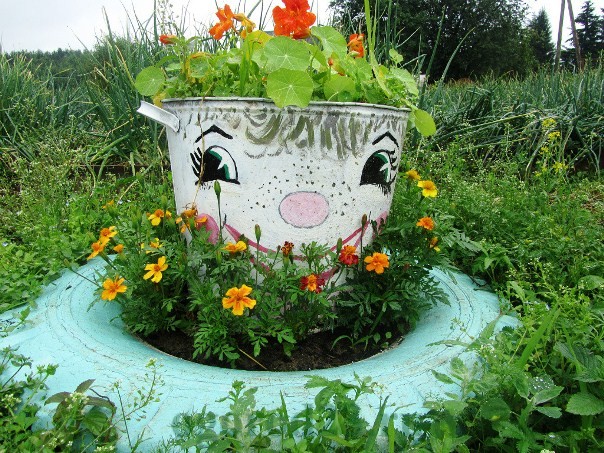
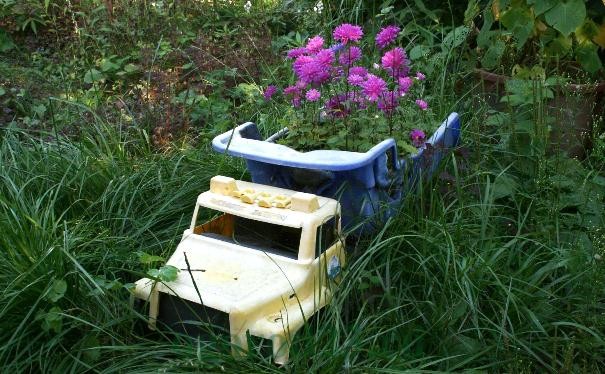
The option presented below rather decorates an already formed flower bed, but the author's creativity deserves attention. It is possible to single out a zone of flower plantations even with the help of disposable spoons, approaching this matter creatively. 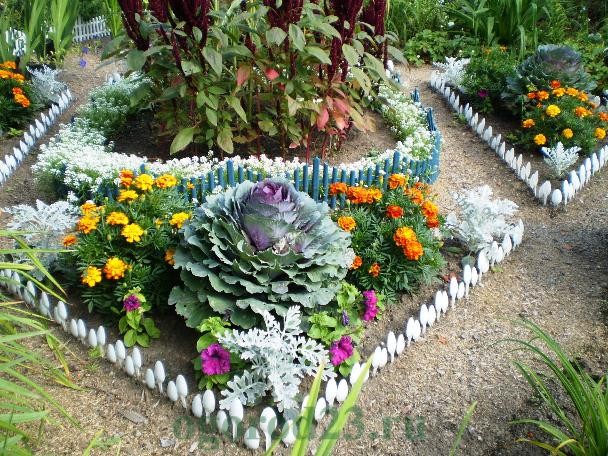
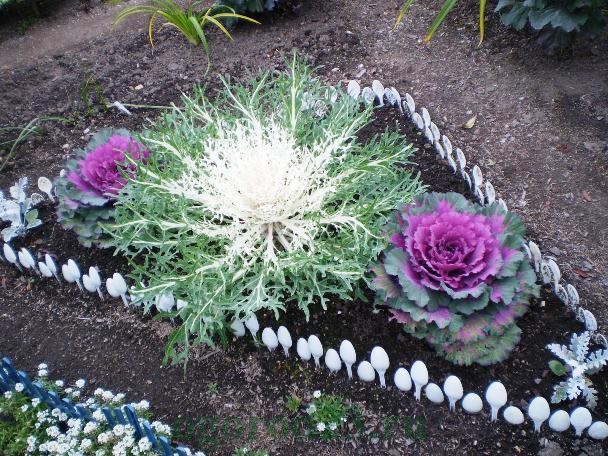
Whatever the flower bed is made of, it must have good drainage. Excessive moisture and stagnant water are detrimental to plants.

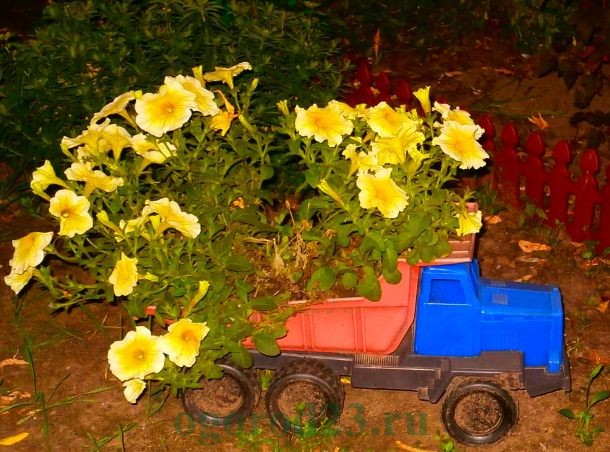
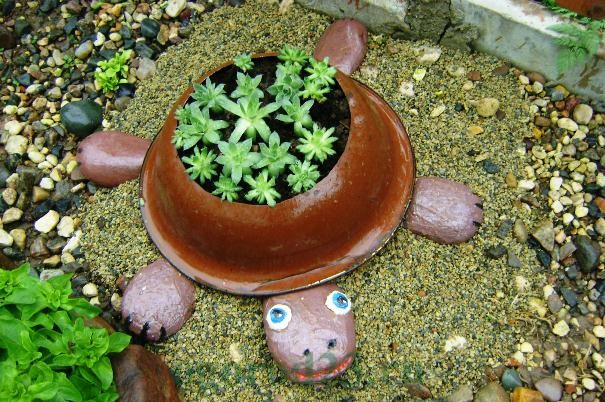
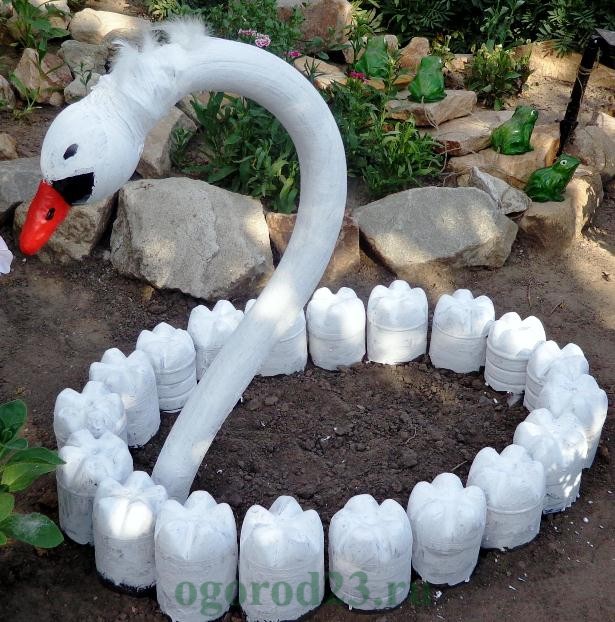

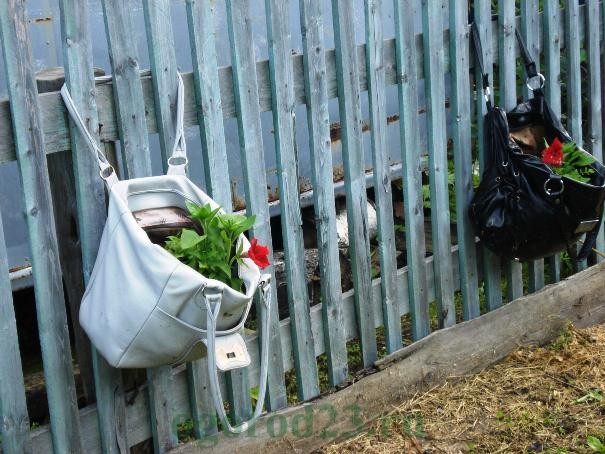
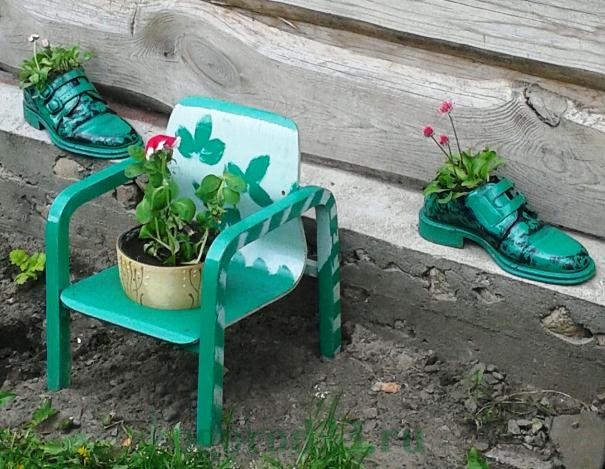
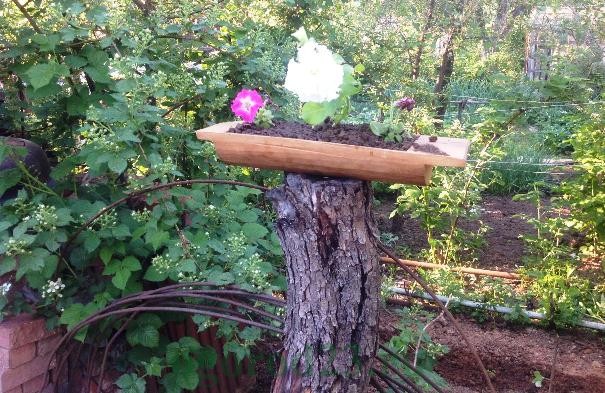
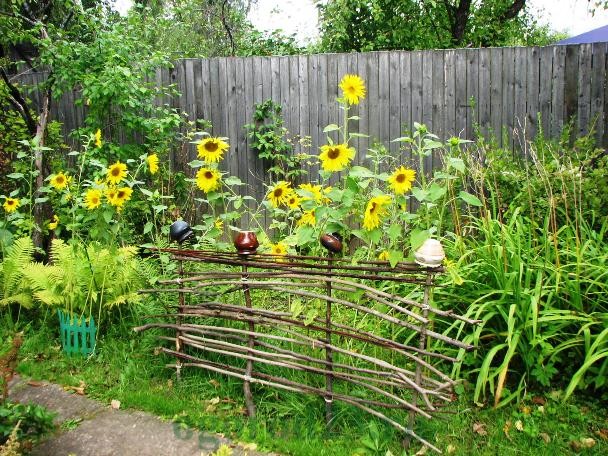
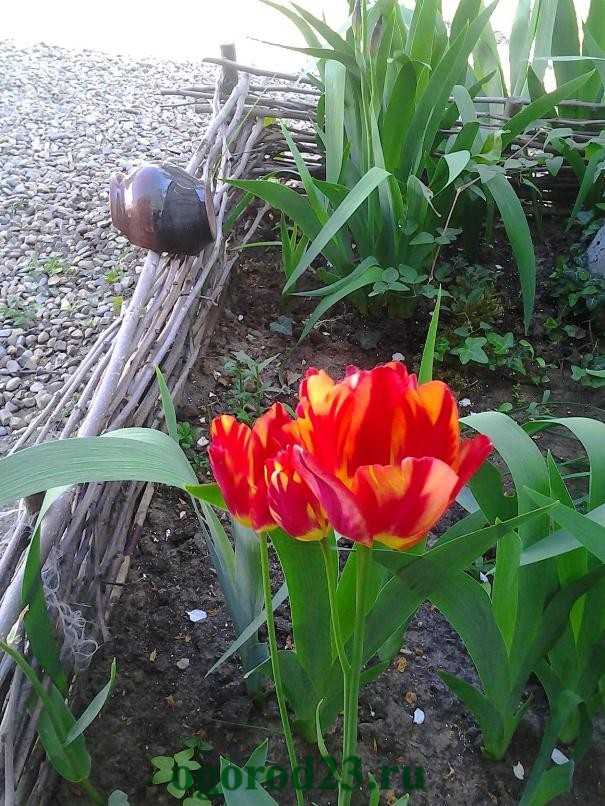
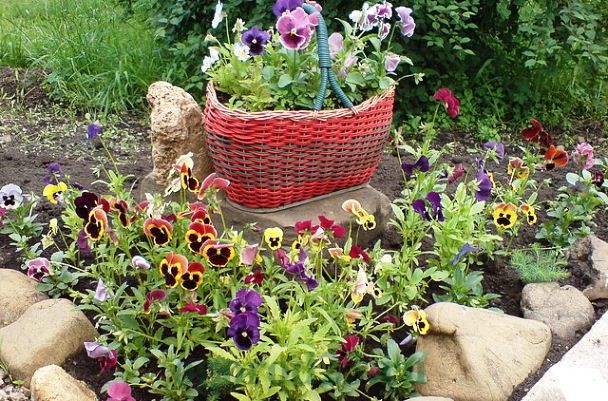
Let's see how you can creatively decorate flower beds and flower beds with your own hands from improvised materials. Let's see a photo of design ideas. We always, everywhere strive to surround ourselves with beauty. Flowers themselves are the decoration of our cottages, garden plots. Even the garden wants to be beautiful! An interesting frame - the design of flower beds, flower beds only emphasizes this beauty. We will not now consider those cases when a certified specialist in landscape design has a hand in the design of the site.
Using your imagination and, sometimes, things that are completely incompatible with the floral theme, you can not only decorate your site, but also give it individuality. Flower beds complete flower plantings, and also perform a protective function. Thus, the roots of ground cover plants are held back by the sides of the original fences, and do not spread over the site. In addition, flower beds act as limiters for curious pets who are not averse to frolic in your flower garden. Even a chipped jar, a sawn log or used car tires can be used as an option for new design solutions. Consider some of the creative techniques of gardeners-summer residents.
Tires or car tires are ready-made small flower beds that are painted in the desired color, and then set on level ground. Fertile soil is poured inside the tires, flowers are planted. You can also figuratively cut out the top of the tire or even give it an intricate shape.
Tires in general represent an extensive field of activity for a creative gardener: they are hung on a fence (for ampelous plants), mounted on top of each other (for vertical gardening), stylized as various shapes.
An old bicycle can also be given new life by first updating it with paint. Drawers, containers with soil are installed or hung on the trunk, frame, seat, even on the pedals, in which flowers will then grow. In this case, the main thing is to securely fasten the bike and its moving parts. A metal pin is usually used, which is buried in the ground, and then the former mobile vehicle is tied or welded to it.
Such a mobile flower bed looks very unusual, while saving space. You can also lean the bike against the fence and tie it well.
It will be interesting to look at a garden wheelbarrow in the form of a flower bed. It is better to pre-sand the old metal structure and renew it with spray paint, the wooden one will look good on its own. Wheelbarrow elements can be partially dug into the ground to give it stability.
Old chairs with and without seats can act as stands for small flower containers. Such a flower bed can be moved anywhere or installed permanently, partially digging the legs into the ground.
A durable option is a flower bed made of stones. Cobblestones, bricks, ordinary stones are used. Such flower beds can be multi-tiered.
You can also arrange fences for flower beds from plastic bottles half dug into the ground. They are placed one after another, the shape of the flower garden can be absolutely any.
Separate containers are used as hanging planters, for example, on a fence - ampelous petunias look good in such a frame. From large five-liter containers, you can make mini-flower beds in the form of animals.
Glass bottle fences are the oldest way to decorate flower beds and flower beds with your own hands. Often, champagne bottles are used for this - they are thick-walled, they have a powerful bottom. Such a flower bed will serve you for more than one year.
With imagination, a garden saw and an ax, you can make amazing flower beds from the trunks of sawn trees, stumps. The log is usually used as a whole or sawn into fragments that are used to decorate miniature flower beds. The bark is either removed or left untouched - this gives even more "naturalness", decorativeness.
The flower garden from previously sawn and peeled logs looks interesting. In the photo below, the flower bed is stylized as a well.
Even from a sawn trunk of a medium-sized tree, you can make a decorative fence and enclose a flower garden.
Even ordinary wooden boards or fragments of timber can be used to fence flower beds.
You can make a multi-tiered flower garden with your own hands from several pots put on an iron pin, which is dug into the ground. And if the pots differ in size, it will be even more interesting.
If you still have an old bath after the repair, why not use it as a flower bed, moreover, it is almost ready. You can dig it into the ground to any depth or leave it in its original form. If you paint it in the color you like, the newly appeared flower bed will only become more attractive.
Anything is used to create flower beds, quite neat fences and fences are obtained from the remnants of building materials.
If you approach the matter creatively, then you can beat any more or less suitable material and give it a new life. For example, from a vine and suitable twigs, you can arrange flower beds-baskets that will look unusual, but symbolic.
You can also give a second life to things that have long served their purpose. For example, children's balls, if carefully cut into halves and filled with soil, turn into pretty flowerpots.
An old basket, a household container, and even children's toys can become a new home for flowers. The photos below clearly demonstrate this.
The option presented below rather decorates an already formed flower bed, but the author's creativity deserves attention. It is possible to single out a zone of flower plantations even with the help of disposable spoons, approaching this matter creatively.
Whatever the flower bed is made of, it must have good drainage. Excessive moisture and stagnant water are detrimental to plants.



